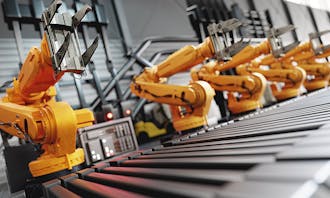The next step in smart food processing
2022-12-12
4 min read
Japan has outlined a blueprint for a new super-smart society — Society 5.0. This vision promises to transform our daily lives by blurring the frontier between cyberspace and physical space, using the Internet of Things (IoT), big data and other smart technologies to resolve social challenges. While the food industry was slow to transition to Industry 4.0, manufacturers can prepare for Society 5.0 and future innovations by integrating the necessary technology.
Society 5.0 is the next step in the region’s technology evolution — using autonomous vehicles and drones to bring goods and services to people and overcome social and environmental challenges. Before it embraces this new paradigm, the food processing sector must ensure that it has fully realised the benefits of Industry 4.0 and smart technology.
Robotics, machine vision, sensors, drones and connected devices can all enhance food processing one way or another. As well as reducing costs and the possibility for human error, automation can improve efficiency, safety and quality.
Machine vision
Like every manufacturing industry, safety is critical in food processing and businesses depend on their production line complying with the necessary standards. Even the hardest-to-inspect products must be assessed with absolute reliability to prevent contamination, and incorrect sorting and packaging. Recalls caused by these issues can result in the loss of revenue and damage hard-earned customer trust.

Vision technology uses cameras and associated software to automatically check products on a manufacturing line at high speed without requiring human input. These systems can detect every inconsistency and inspect products far faster than any human could. As well as operating 24/7 without breaks, many machine vision systems will log the data from their inspections and store it for the manufacturer to access and review.
X-ray detection systems are also becoming more popular, with manufacturers using them to detect contaminants in food products. Integrating this technology provides an extra layer of quality control by detecting metals, glass, sandstone, shale and other materials. More advanced systems can also detect contaminants that contain higher-value elements such as PVC, PTFE, salt lumps and bone. Meanwhile, manufacturers can use X-rays to highlight other product defects, whether it’s missing products in packings, erroneous air bubbles or broken products.
Sensors
The rise of connected systems is clear, with McKinsey estimating that the worldwide number of IoT-connected devices will increase to 43 billion by 2023. Smart sensors are a key example, harnessing wireless connectivity to export data and support evidence-based decision-making. Integrating sensors can help manufacturers gain a detailed insight into their production processes. Once they know what type of data they need, manufacturers can select a suitable type of sensor to monitor, analyse and process changes in their facility and on the production line.
Sensors can measure and control anything from temperature and pressure to solid and liquid levels. Temperature sensors are possibly the most common in food processing environments because they are ideal for appliances like refrigerators, and will alert manufacturers to any abnormalities, say, if an electrical motor is overheating and risks downtime. When selecting a temperature sensor, manufacturers must choose between thermocouples, thermistors, resistor temperature detectors (RTD) and infrared sensors, and the choice will depend on the application.
Other options are available. For instance, pressure sensors measure the force per unit applied to the sensor and will detect things like the pressure of a stored gas or liquid in a sealed vessel. This type of sensor can detect any fluctuations or drops in pressure and is often used when maintaining water and heating systems.
Retrofitting
While Society 5.0 seems almost utopian and futuristic, most food processing facilities are closer than they realise. For food manufacturers that have not yet fully embraced Industry 4.0, retrofitting legacy equipment can offer a strong return on investment and pave the way to a smarter set-up.
While almost every food processing site will have perfectly functioning legacy equipment, like sensors, drives and PLCs, as this technology advances, these machines may need to be integrated with newer alternatives, already equipped with connected capabilities. This option can be costly, so at a time when expenses are high, there are more cost-effective and simpler solutions than simply overhauling the entire system and starting from scratch.
Instead, manufacturers can retrofit smart technologies, like smart sensors and x-ray systems, and newer human-to-machine interfaces that will streamline the transition to Society 5.0. For example, a smart temperature sensor can be fitted to a variety of legacy machines and its output will help determine the manufacturer’s predictive maintenance program. Once it detects a failure, they can then order a replacement from a reliable parts supplier.



